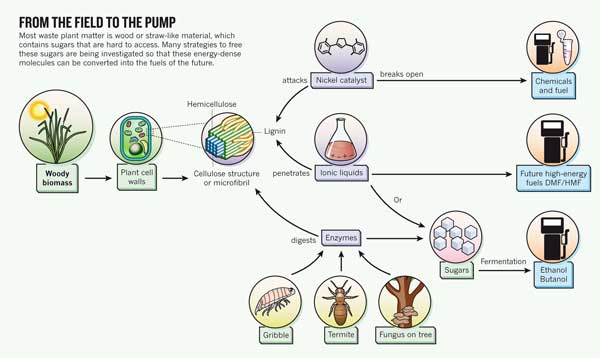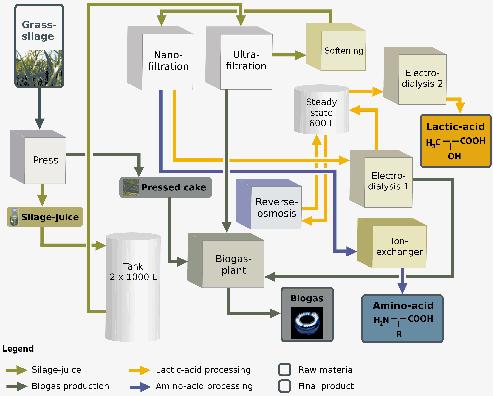Biorefinery
Basics
A biorefinery is capable of producing and isolating refined materials from organic (agricultural) feedstocks. Biorefineries follow a series of steps that can be generalized to be pretreatment, treatment, and purification. Pretreatment breaks apart and fractionates the biomass to make recalcitrant components available for treatments and to direct the component streams to the desired treatment process. A biorefinery utilizes single or multi-step pretreatment to initially separate fractions of different biomass components (sugars, cellulose, hemicellulose, and lignin). Treatment involves breaking apart the feedstock to desirable components or conversion of substrate components to desirable products, an example of the former is dealkylating aromatics in lignin, and an example of the latter is to direct sugars to fermentation for the production of ethanol, lactic acid, etc. Purification is necessary to form fractions of pure desired products.
Background
Pretreatment can include steam explosion, enzymatic treatments, strong or dilute acid, and/or physical treatments such as milling or Vortex Dehydration. Fractions of enriched components are processed in treatment steps such as saccharification, fermentation, and/or purification to produce high quality refined products. Treatment may include fermentation, catalytic conversion, pyrolysis, and other decomposing processes. Products directly from the feedstock can be stock chemicals such as aromatics, substrate materials such as lactic acid, or energy containing molecules such as ethanol and biogas. Biorefinement not only starts with biological feedstocks but often utilizes microorganisms for processing and conversion step. This technique sacrifices some sugar components but produces a desirable product with little to no inputs. Purification can involve distillation or membrane exchange.
Economic significance
Biorefineries gain efficiency by integrating multiple refinement processes into a series of processes in a single location, so that the feedstock can be completely processed with minimal transportation and without duplicating chemical treatments. Biorefinery equipment can be moved from farm to farm as another method to avoid transportation of bulky feedstocks.
OSE context
Arguably, a biorefinery is fundamental to achieving post-scarcity through the import substitution of chemicals and basic materials with locally produced agricultural derived replacements. There may be be other non-biological sources for certain needed stock chemicals, but organic (C-C bonded) molecules will almost certainly be refined from biological sources. It is established in the art and science that biorefinement achieves highest efficiency by minimizing transportation of bulky feedstocks and tailoring a refinery to the locally produced agricultural products. These aspects are already in-line with OSE guidelines. Biorefineries produce much of their own power from combustion of the spent agricultural waste and is already in line with the broader OSE strategy.
An OSE biorefinery will be developed according to OSE guidelines maximizing modularity and allowing reconfiguration for different circumstances. In developing OSE biorefinement techniques, a primary focus should be on developing product ecologies and import substitution. Certain techniques such as fermentation, chemical purification, and local production of key components should be pursued and integrated into a cohesive process. Currently biorefinement efficacy is measured by life-cycle analysis and profitability/valorisation, however these matrices are not applicable to OSE goals and a matrix of import substitution should be used to measure OSE biorefinery efficacy.
OSE development
- Research and development of an OSE biorefinement process that begins with a sugar and hemicellulose saccharification process, extraction of cellulose, followed by decomposition of lignin to aromatic compounds is proposed as the basis for import substitution.
- Membrane technology is key to many refinement steps and Cellulose acetate membrane development will focus on biorefinement (in addition to water purification) applications.
- Fermentation products of different microorganisms include Ethanol, Lactic acid, and acetone-butanol-ethanol
- Silage is a method of storing animal feed utilizing lactic acid fermenting bacteria. High value lactic acid and amino acids may be recovered from a press juice before the feed is given to animals. A demonstration plant has been successfully tested in Austria, see below.
- Pyrolysis utilizes anaerobic distillation to breakdown organic feedstocks to "components". The tar component is primarily the lignin fraction which contains high concentrations of aromatics and could be a source of benzene and phenol.
Preliminary outline of process
Different feedstocks may lend themselves to either a single round of resource extraction or multiple types of material may be extracted from a single feedstock; energy/resource balance analysis should be used to decide between different schemes. In the context of OSE, energy balance may be maximized by growing (certain) feedstocks for a specific utility, performing extraction, and using the remaining bagasse for combustion, conventional composting, biogas production, or mycelium feed.
Alternatively, multiple rounds of resource extraction may be used to maximize the material obtained, as in the following scheme.
1. Feedstock is treated with dilute mineral acid and steam explosion to break apart fibers and release hemicellulose bound sugars. The pretreated feedstock is pressed, neutralized, and the sugar rich extract fed to microorganism production platforms.
2. Bagasse is dried and subject to cellulose acetate extraction using acetic acid and acetate anhydride.
3. The residuals should be largely insoluble lignocellulose which can be used for pyrolysis/hydrocracking.
Pretreatment
See Pretreatment.
Example
Membrane based production of lactic acid and amino acids – green biorefinery Upper Austria
J. Ecker, 1M. Harasek
Vienna University of Technology, Institute of Chemical Engineering, Getreidemarkt 9/166-2, 1060 Wien, Tel.: +43-1-58801-15978,
e-mail: jecker@mail.zserv.tuwien.ac.at;
Vienna University of Technology, Institute of Chemical Engineering, Getreidemarkt 9/166-2,
e-mail: michael.harasek@tuwien.ac.at
source: here
Within the project "Green Biorefinery Upper Austria" a demonstration plant for the separation of resources from grass silage was built up and operated near the biogas plant in Utzenaich (Upper Austria). The aim of the project, which includes the OÖ Bioraffinerie GesmbH, Joanneum Research Forschungsgesellschaft mbH and BiorefSys as partners, is to produce lactic acid and various amino acids from pressed silage juice.
The juice is pressed from silage bales of farmers in the vicinity of the bio-refinery. The material varies from normal grass to special grass clovers, which contain higher amounts of potential resources. After sedimentation, the process (Figure 1) is started with the production of the acid containing streams. The first step is an ultrafiltration unit in which disturbing macromolecules and proteins can be separated from the product stream. After this first clarification step the stream is fed into a nanofiltration unit. This standard unit operation allows the separation of phases enriched in amino acids and phases enriched in lactic acid. The divided streams are processed in two separated ways. The phase loaded with amino acids is cleared in an ion exchange street. Streams having concentrated amounts of specific amino acids fractions are produced in this step. The lactic acid stream is fed into two serial electrodialysis units. In the first unit the stream is desalinated. The varying amount of salts in the feed can be compensated with different dwell times. The salts are migrating into the concentrate cycle, which is the waste stream of this step. The desalinated stream is fed into a reverse osmosis plant to increase the amount of lactic acid and to reduce the volume to be pumped. The concentrated stream is the feed for the second electrodialysis unit, which separates the lactic acid from the diluate. Due to its structure, the acid is migrating slowly. The transport can be enhanced by increasing the current density and the dwelling time in the tanks. One of the most important advantages of the “Green Biorefinery” is that no waste is produced. All of the accumulated by-products, i.e. press-cake, ultrafiltration-retentate and electrodialysis concentrate, can be used as substrates in the adjacent biogas plant Utzenaich. The other product free streams are recycled in the “Green Biorefinery” itself.
The product streams will be used for different applications. For example, there are uses of lactic acid in the animal food industry or in the chemical industry as a precursor of ethyl lactate. The amino acids are used in the food industry or in cosmetics and pharma industry. This process still needs improvements to achieve high product quality to be less dependent on the raw materials. In the 30 month duration of the project the procedure will be optimized and, if necessary, changes are made in the build up to produce economic products.
Within this work, first process results of the electrodialysis systems for the lactic acid production will be presented. Additionally, initial system performance and first operating experiences during continuous campaigns will be reported.
Goals of the biorefinery program were:
1. Utilisation of Grass Fibres 2. Separation of Proteins from Grass Juice (Green Juice) 3. Separation of Lactic Acid from Grass Silage Juice (Brown Juice) 4. separation of valuable substances from grass silage juice 5. Primary Processing and Utilization of Fibres from Green Biomass
Some of the major findings of the project were:
- not too difficult to separate lactic acid and crude protein
- the press juice appears to be a suitable raw material for further processing, to separate lactic acid from amino acids
- about 85-95% of total lactic acid in the silage can be transferred to the press juice
- amount of crude protein recovered varies by silage used (alfalfa vs. grass)
Product ecology
Major Componets
Anerobic Digester
- Anerobic Digestion
- Produces Biogas , Digestate , and Leachate / Wastewater
Bio-crude Refinery=
- Biocrude Refinery handles the Bio-Crude , as well as the Pyrolysis Oil (potentially? supposedly VERY bad with Catalyst Poisoning ?)
- Would produce wastewater, gasses, and Petcoke which would feed to other units
- Also the majority of the Petrochemicals (short of maybe Plastics and other chemicals which would have dedicated plants in the Eco-Industrial Park )
Fermenters
Gas Processing
- Mix the "Light Ends Unit", Biogas Upgrader , and any sort of Gaseous Hydrocarbon Reforming setup into a "sector"
- Also maybe non G2L syngas processes? (So Water Gas Shift Reaction and Syngas to Methane ?)
- Produces Hydrogen , LPG , Methane , Syngas , and Carbon Dioxide
HTL Unit
- Uses Wet Biomass
- Produces Bio-Crude
Pyrolysis + Gasification Unit
- Pyrolysis then Gasification
- Pyrolysis will most likely by dry biomass, and could co-process RDF
- The resulting Slag / Bottom Ash / Pyrolysis Oil / Coke would need processing
- The gasifier would use Charcoal , Coke , Petcoke , and any other form of near-pure carbon
- Producing Syngas
Components
Screw press
Membrane filtration
Possible Products
Internal Links
External links
- paper "Integrating Biomass Feedstocks into Chemical Production Complexes using New and Existing Processes" (Louisiana State University)
- paper: Techno-economic and environmental evaluation of lignocellulosic biochemical refineries: need for a modular platform for integrated assessment (MPIA)
- paper: Production of bioethanol and other bio-based materials from sugarcane bagasse: Integration to conventional bioethanol production process
- NREL: "What Is a Biorefinery?"
- US DOE: "A Biorefinery Goes 'Mod' and Small", mentions company: Easy Energy Systems
- Book chapter (.pdf) "The Biorefinery Concept–An Integrated Approach" (from book: Introduction to Chemicals from Biomass, Edited by James Clark and Fabien Deswarte, 2008)
Under review
Biorefinery process and techno-economics
http://www.csa.wur.nl/NR/rdonlyres/A5F6D7EE-42E2-460A-9A0F-A90DBCB8071A/163824/JBB_June_2012.pdf
https://www.upc.edu/sostenible2015/menu2/Seminaris/Post_Seminari_STD/docs/article-anneliese.pdf
http://www.qibebt.cas.cn/xwzx/kydt/201202/P020120223409482956847.pdf
http://curis.ku.dk/portal-life/files/37734558/Working_Papers_70_2012_Advanced_Biofuels.pdf


